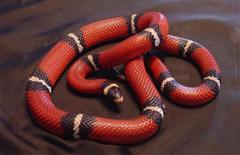Milksnake - Sinaloan
Sinaloan Milk Snake Scientific Name: Lampropeltis triangulum sinaloae
Thu, 10th July, 2025 - 1:42 am GMT
Sponsor Ads:

Alternative Name
Sinaloan Milk Snake Scientific Name: Lampropeltis triangulum sinaloaeBasic Info
The moderately sized Sinaloan Milksnake averages about 3 feet in length. Their black heads have black eyes and a cream marking on their snout. Sinaloan Milksnakes are very vibrantly colored, primarily bright red with many pairs of black bands filled with white or a cream color. The scales are smooth and shiny. These are often confused with the Nelson's Milksnake, but the Nelson's has a narrower red band.
Health
In captivity the Sinaloan Milksnake should be housed in at least a 15 to 20 gallon aquarium, with an escape-proof screen lid. As far as lighting, normal indirect window lighting is sufficient. This species likes to burrow and it is important to provide enough substrate to make this possible. Some good choices are sand, small smooth gravel, wood chips (not cedar) pine shavings, aspen bedding, and maybe one-half of the tank covered in dry moss. It is equally important to provide hiding spots at both ends of temperature gradient (75 to 88 degrees Fahrenheit); these can be as simple as folded sheets of paper. If a temperature gradient cannot be provided the constant temperature should be maintained between 84 and 86 degrees Fahrenheit. Ventral heat is the preferred method for warming the tank, Milksnakes don't bask so using light to provide heat is inappropriate. These snakes do well on a diet of mice; the size will vary depending on the size of the snake. After the first shed, hatchlings should be given a pinkie mouse once a week. They will show a small lump after feeding. The feeding habits of males and females are different and they should be fed accordingly. Adult males should be given one meal a week and they may not eat during mating season. Mature females should be fed two times per week for breeders. Gravid females should be given smaller prey items. Some females do not eat when gravid, but still offer prey frequently. Stop feeding two weeks before brumation. Some individuals may be problems feeders. If this is the case place them in a small, clean, dry cage, and provide a temperature gradient of 75 to 88 degrees Fahrenheit using a sub-tank heat source. Provide clean drinking water, an appropriate substrate and multiple hiding spots. Because this snake may be ophiophagus (snake eating) it is not generally advisedHabitat
N/ABehavior
The Sinaloan Milksnake is a popular snake among hobbyists because of its mellow personality and striking tri-colored pattern. Sinaloan Milksnakes are average sized Milksnakes found in the United States and Mexico. They are beautiful animals and are rarely aggressive, although they may be nervous and snappy when young or when first acquired. An active, alert animal, the Sinaloan Milksnake is a delight to its keepers. In the wild, they feed on small mammals, including rodents and are also known to feed on lizards, frogs, and even other snakes on occasion. They are generally docile snakes, although nervous snakes may bite. Like many other snakes, with frequent handling they should become relatively non-aggressive and easy to handle, even for novice snake owners. For this reason they are considered a good snake for beginners.Origin
North AmericaHistory
Sinaloans are a type of Milksnake that is found in the southwestern United States and Mexico.Common Foods
They are valued as wild animals on the farm and in urban areas as they eat mice and other rodents.Sponsor Ads:
Now what is history? It is the centuries of systematic explorations of the riddle of death, with a view to overcoming death. That's why people discover mathematical infinity and electromagnetic waves, that's why they write symphonies. -- Boris Pasternak, Doctor Zhivago
Milksnake - Sinaloan
Coded by: BGID® | ALL RIGHTS RESERVED Copyright © 2000-2025
Disclaimer | Privacy | Report Errors / Contact | Credits









